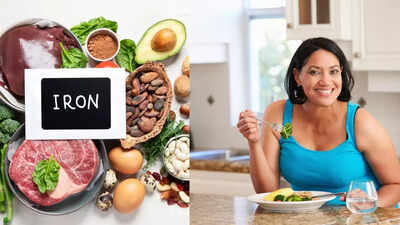ARTICLE AD BOX

Are you struggling with weakness, shortness of breath or sudden inflammations, then these may be the indicators of depleting iron levels in the body. In fact, women need more iron as they age and this is majorly due to hormonal changes, menstruation, low-metabolism, and poor absorption of nutrients from the food, which often leads to an increased risk of iron deficiency and anemia, which affects energy, immunity, and cognitive functioning.
Here’s all you must know about the need for iron rich foods in women as they age. Why is iron important for health?There’s no denying that iron is an essential mineral required for better functioning and overall health. This is primarily because iron is an essential mineral needed for producing hemoglobin, the protein in red blood cells that transports oxygen from the lungs to tissues throughout the body. Hemoglobin is vital for maintaining energy levels, supporting brain functioning, muscle activity, and helps boost the immune system.
In fact, iron also contributes to the synthesis of myoglobin in muscles and various enzymes that drive metabolic processes. Without adequate iron, the body cannot efficiently produce energy, leading to symptoms like fatigue, inflammation, impaired cognitive function, and increased susceptibility to infections. However, maintaining healthy iron levels is important, especially for women to post 40’s as iron deficiency like anemia is a common issue in women and can also significantly lower quality of life.
What studies sayAccording to a study published in the National Library of health about ‘The role of iron in the immune response to bacterial infection by Bobby J Cherayil in 2011, wherein the study highlighted the importance of iron and its role in improving immune response modulation, emphasizing how iron deficiency hampers the body's ability to fight infections effectively and impacts overall health. This demonstrates the broad significance of iron not only for oxygen transport but also for maintaining metabolic and immune health essential throughout life.

Iron rich foods can help maintaining the right level of the mineral in the body.
Why women need more iron as they ageWomen of reproductive age lose iron through menstruation, which increases dietary iron needs. Post-40, iron absorption may decline slightly, but maintaining adequate intake helps prevent anemia, supports brain function, and preserves immunity. Studies confirm that iron deficiency is common in women over 40 and linked to fatigue and decreased quality of life, highlighting the need for iron-rich diets.7 Dinner recipes that may boost iron absorption in women post-40Spinach and Lentil SoupTo make this simple dish, wash and combine spinach with lentils, tomato, ginger garlic and add in a choice of spices, blend the soup and add in some ghee for better health. This soup is rich in iron and protein-packed with lentils and vitamin C from tomatoes, this soup enhances iron absorption while boosting immunity and energy. Herbs like cumin improve digestion and nutrient uptake.

Beetroot and Quinoa SaladThis simple dinner delight can be made by grating beetroot and cooking it with quinoa, spices and pumpkin seeds. Before serving add a splash of lime juice for better absorption. This beetroot and quinoa provide plant-based iron and folate, with quinoa offering complete protein. Adding lemon juice and pumpkin seeds further enhances iron content and adds some healthy fats.Palak Paneer with Bajra RotiThis classic dinner is great for health and boosting iron levels, this is because palak (spinach) and paneer gives the body a healthy boost of non-heme iron and protein.
Apart from that, this iron-rich bajra (pearl millet) roti is great when tomatoes are added to the palak paneer curry as it is loaded with vitamin C from tomatoes and iron content in the spinach also improves iron absorption.Moong Dal and Cauliflower Greens AppeAnother simple dish, which is a perfect dinner meal. This fermented, iron-rich lentil-based savory dish is made with cauliflower greens, which are high in iron and vitamin C, supporting better iron uptake and digestion.Ginger Garlic Tomato Tofu BhurjiThis delicious twist to desi bhuji is perfect for people with iron deficiency. This is because tofu provides health plant-based iron and protein, while tomatoes and garlic add vitamin C and aid absorption. This dish is immune-boosting and easy to digest.

Whole Moong & Green Peas KhichdiThis is a delicious and light dinner for busy days, which is made with whole moong beans and green peas, both iron-rich, with brown rice for sustained energy.
Tomatoes and coriander provide vitamin C for enhanced absorption. Stir-fried Tofu and VegetableLastly, this simple tofu recipe, which is made with vitamin C-rich bell peppers, broccoli, and lemon juice, optimizes non-heme iron absorption while providing a delicious, healthy dinner option.Simple tips to enhance iron absorption from meals include:Eat vitamin C-rich foods alongside iron sources: Vitamin C converts iron into a form more easily absorbed by the body.
Include citrus fruits, bell peppers, tomatoes, broccoli, and strawberries with your meals to boost iron uptake.

Combine heme and non-heme iron sources: Eating meat, poultry, or fish (heme iron) along with plant-based iron foods (non-heme iron) can significantly increase overall iron absorption.Fermented foods are beneficial: Organic acids in fermented foods like sauerkraut, kimchi, and soy sauce enhance iron absorption by reducing inhibitors in foods.Avoid inhibitors at mealtime: Limit intake of tea, coffee, calcium-rich dairy, red wine, and high-phytate foods (e.g., unfermented whole grains and legumes) around iron-rich meals as they impede absorption.Soak, sprout, or ferment legumes and grains: These processes reduce phytates, natural compounds that block iron absorption, making iron in plant foods more bioavailable.Use cast iron cookware: Cooking acidic foods in cast iron pans can increase the iron content of your meals.Include lysine-rich foods: Proteins containing lysine, such as legumes and quinoa, may help enhance iron uptake.

 2 hours ago
5
2 hours ago
5









 English (US) ·
English (US) ·